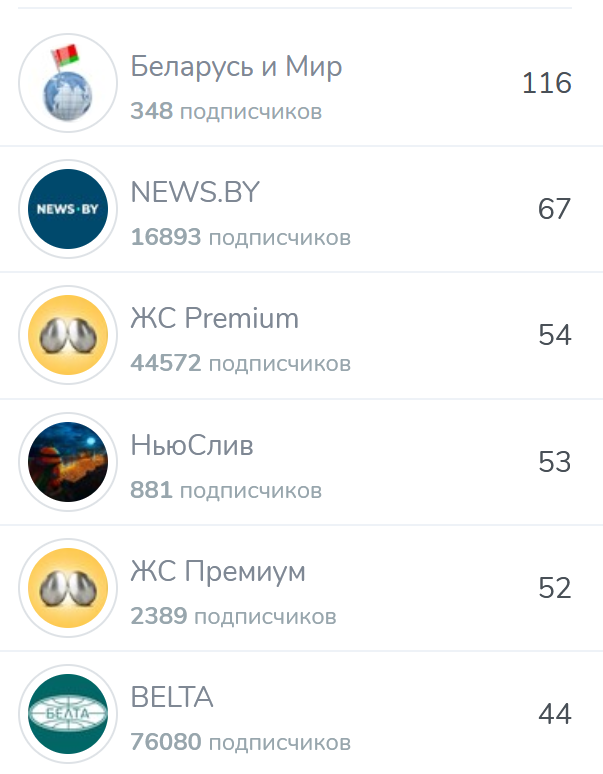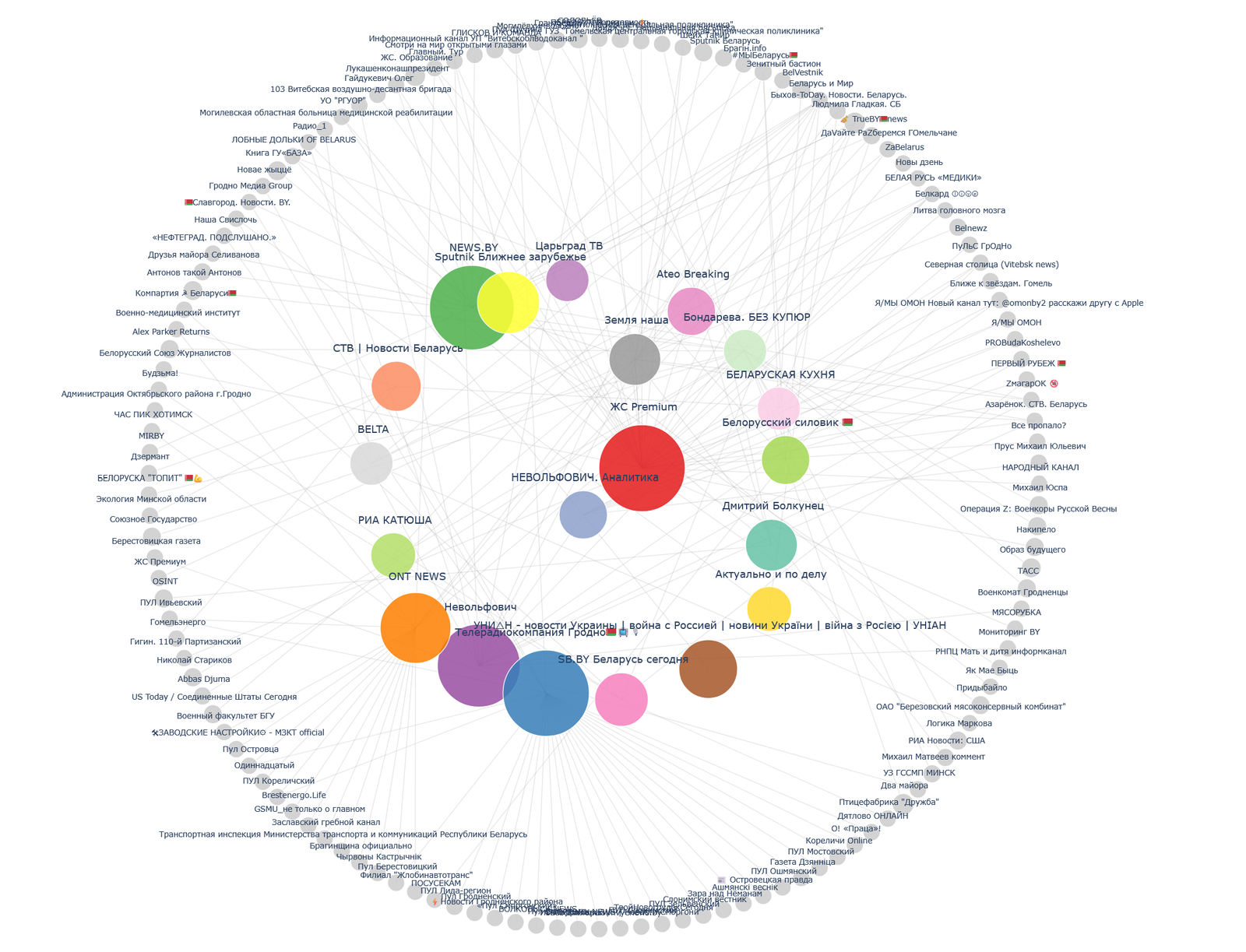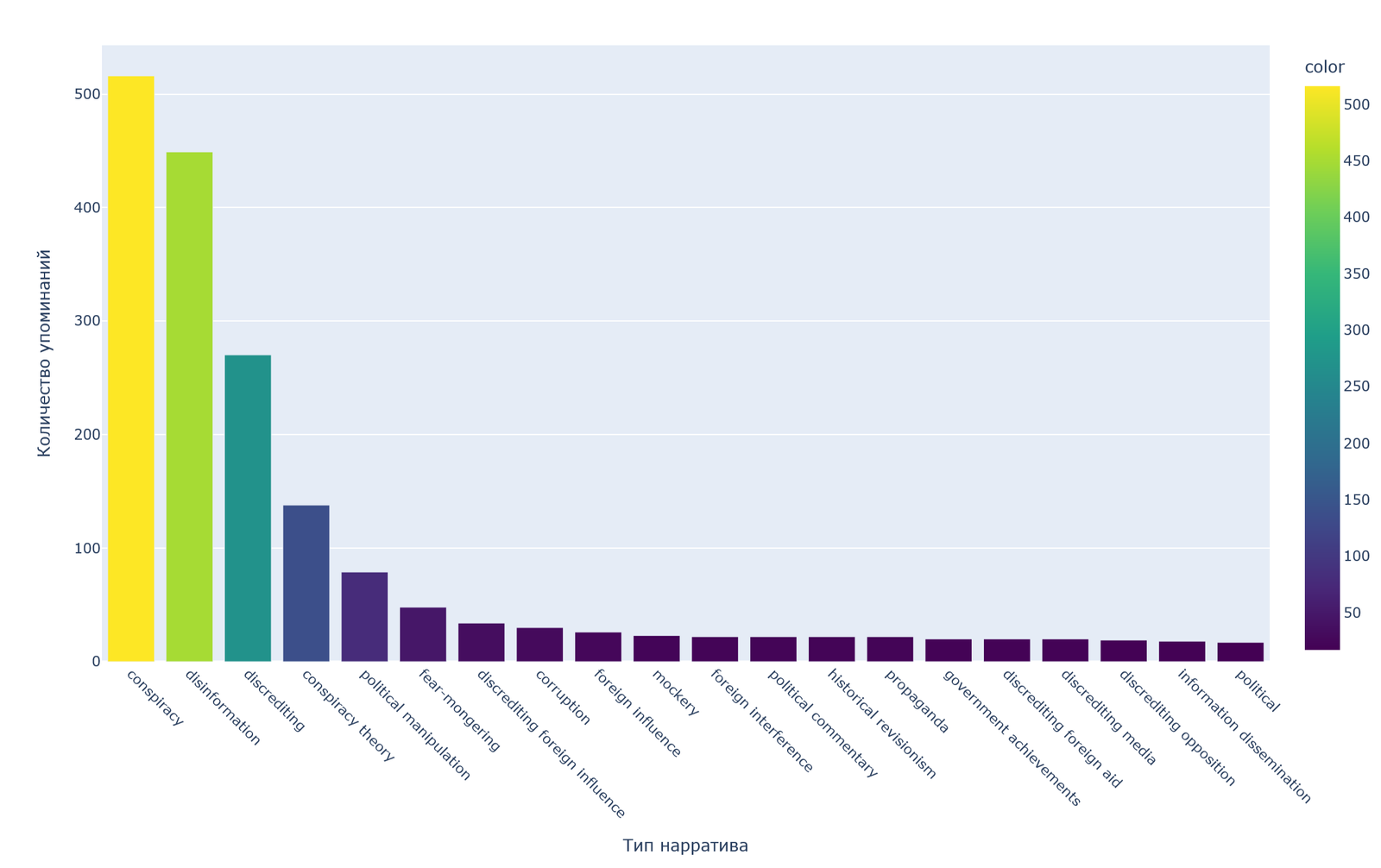In the second half, the number of publications about the United States Agency for International Development (USAID) in Belarusian Telegram channels increased sharply
A dataset consisting of 1,686 publications in Belarusian Telegram channels for the period from January 1 to February 20, 2025 was collected. The graph shows the distribution of these publications and the number of views:

The maximum number of mentions and views occurred on February 3: 190 mentions and 1,668,107 views. These publications were posted on 281 channels, with a total of 11,215,969 views.
This graph demonstrates a typical model of information dissemination in social media with a rapid increase in popularity, a peak, and a subsequent long-term decline in interest. It is important to note that the “tail” remains for quite a long time, which indicates that the topic maintains resonance in the information field.
Most publications mentioning USAID were made on the following channels:

It can be noted that all of them can be classified as toxic and represent Belarusian media with state ownership (News.by, BELTA).
Background to the News
Over the past month, the United States Agency for International Development (USAID) has faced serious allegations and organizational changes initiated by the administration of President Donald Trump.
Allegations of Waste and Abuse
In February 2025, the Trump administration announced plans to close or significantly reduce USAID, citing alleged instances of waste and abuse. The White House cited several projects that it claimed demonstrated misuse of funds, including:
- $1.5 million to advance diversity, equity, and inclusion (DEI) in the workplace in Serbia.
- $70,000 to stage a DEI-themed musical in Ireland.
- $47,000 for a transgender opera in Colombia.
- $32,000 for a transgender comic strip in Peru.
However, only one of these projects was actually funded by USAID; the others were State Department initiatives, suggesting possible exaggeration or misrepresentation of the extent of the alleged abuses.
Reorganization and Cuts
In early February 2025, Secretary of State Marco Rubio was appointed acting administrator of USAID. Shortly thereafter, the administration announced plans to cut the agency’s workforce by 97%, leaving just 294 employees out of more than 10,000. On February 7, a notice appeared on USAID’s website stating that, effective 11:59 p.m., all employees except those responsible for critical functions would be placed on administrative leave.
Reaction and Consequences
A number of experts and organizations have expressed concern about the potential negative consequences of such actions. Former USAID Administrator Samantha Power noted that closing the agency could lead to the strengthening of autocratic regimes around the world. In addition, critics point out that reducing or eliminating USAID could negatively affect global humanitarian initiatives and U.S. foreign policy.
As a result, USAID has been in the spotlight over the past month due to allegations of misuse of funds and subsequent organizational changes, sparking a broad debate about the future of American foreign aid.
Repost Analysis
A directed repost graph was built to analyze the structure of information dissemination, identify key distribution channels, and understand the connections between channels.
The graph shows: nodes (circles) – Telegram channels, edges (lines) – reposts between channels, the node size is proportional to the number of channel views. The color of the node indicates its affiliation with the top 20 channels by the number of reposts. Channels outside the top 20 are marked in gray.

A hybrid layout of two types was used. In the center is a force-directed (spring layout) for the top 20 channels, which allows for the optimal placement of the most active nodes. Around the circumference – circular layout for the remaining channels, which ensures readability of peripheral nodes.
The full interactive version of the graph is here.
The resulting graph allows us to track the main routes of information dissemination:
It is clear that information is often distributed from large media channels to smaller ones
There ist chains of consecutive reposts: original channel → major media channel → regional channels → local groups.
Some channels act as “bridges”, linking different information clusters. Groups of channels that regularly exchange content with each other are noticeable.
Premium has the largest number of incoming and outgoing links, indicating its central role in the network
Grodno TV and Radio Company (42 reposts) is an important regional distribution hub
NEWS.BY (29 reposts) and Nevolfovich (28 reposts) form significant secondary distribution centers
A group of channels with 8-16 reposts is noticeable, which form the “middle layer” of distributors
Assessment of the scale of information coverage:
- The main core is formed by about 20 channels with the largest number of reposts
- Most information is distributed through 5-6 key nodes
- Peripheral channels (with 1-2 reposts) make up about 60% of the total number of network participants
- There is a significant spread in the number of views – from several hundred to tens of thousands
When analyzing publications in Telegram channels, it is always recommended pay attention to publications and reposts made at the same time. The analysis of the studied dataset yielded the following results.
General structure of clusters:
- 27 clusters of simultaneous publications were found
- Each cluster has from 2 to 6 simultaneous reposts
- Average value is 2.26 reposts per cluster
This indicates a systematic nature of information dissemination, where most often information is distributed in small groups (2-3 reposts), but there are also cases of more massive simultaneous distribution (up to 6 reposts).
Analysis of the main sources:
Grodno TV and Radio Company (16 cases) is the clear leader in participation in simultaneous reposts, UNIAN (7 cases) and ZhS Premium (6 cases) form the second tier. Our Land and Dmitry Bolkunets (4 cases each) round out the top 5
Signs of centralized control:
High frequency of participation of the Grodno Television and Radio Company (16 out of 27 clusters) indicates a possible coordinating center
The presence of a stable group of 5 main sources suggests an organized distribution structure
A relatively small average number of reposts (2.26) may indicate a desire to avoid obvious signs of centralized control
Features of distribution:
The predominance of small groups of reposts (2-3) may be a tactic for less noticeable distribution
The maximum number of 6 simultaneous reposts is probably used for important information leaks
Regular participation of the same sources indicates a stable distribution network
Coordination at the level of the main sources is obvious. There is a distribution hierarchy with a clear leader (Grodno Television and Radio Company). A systematic approach to the dissemination of information is traced. The presence of a common coordination center for the main participants of the network is likely. These data confirm the hypothesis about the centralized nature of information dissemination, although the system is built flexibly enough to not create too obvious signs of coordination.
Analysis of narratives
Our next step was to analyze the narratives of publications. For this, the fine-tuning LLM model gpt-4o-mini was used.
The graph shows the distribution of types of disinformation narratives by frequency of their use:

Dominant narratives:
- “Conspiracy” – about 500 mentions
- “Disinformation” – about 450 mentions
- “Discrediting” – about 270 mentions
Average level of use:
- “Conspiracy theory” – about 140 mentions
- “Political manipulation” – about 80 mentions
- “Fear-mongering” – about 50 mentions
Least used narratives (less than 30 mentions each):
- “Political commentary” – Political commentary
- “Historical revisionism” – Historical revisionism
- “Propaganda” – Propaganda
- “Government achievements” – Government achievements/successes
- “Information dissemination” – Dissemination of information
- “Political opposition” – Political opposition
Analysis of the results:
The predominance of conspiracy narratives indicates that the most popular disinformation strategy is the creation of conspiracy theories and complex conspiracy theories.
The high frequency of using disinformation and discrediting narratives indicates a deliberate strategy to undermine trust in certain individuals, organizations or information.
The relatively low frequency of using “pure” political narratives may indicate that disinformation authors prefer more complex and emotionally charged forms of manipulation over direct political propaganda.
The low number of narratives related to historical revisionism and government achievements may indicate that these topics are either less effective for disinformation purposes or require more complex content preparation.
The next important graph is the heat map of usage by channel.

The most active channels:
- “Belarus and the World” – actively uses almost all types of narratives, especially conspiracy theories
- “NEWS.BY” – highly active in spreading disinformation and conspiracy theories
- “ZhS Premium” and “ZhS Premium” – similar patterns of using narratives, which may indicate related channels
Full interactive version of the graph here.
Patterns of narrative usage:
- “Conspiracy” is used most intensively by almost all channels
- “Disinformation” is also widespread
- “Discrediting” is actively used by the top group of channels
“FRONTAL LOBE OF BELARUS” and “SB.BY Belarus Today” have similar patterns of narrative usage
“Sputnik Belarus” and “BELTA” show more moderate usage of different types of narratives
Some channels (e.g. “MIRBY”) show narrower specialization in the types of narratives used
Weakly used narratives:
- “Political opposition”
- “Information dissemination”
- “Historical revisionism”
- “Government achievements”
There is a clear hierarchy of channels by the intensity of disinformation dissemination. Most channels focus on conspiracy and disinformation narratives. There is coordination in the use of certain types of narratives between some channels. Political and historical narratives are used less actively than conspiracy ones.
This visualization helps to identify the main sources and patterns of disinformation dissemination, which can be useful for developing counteraction strategies.
Detailed statistics on narratives:
| Narrative | Total number | Number of channels | Top 3 channels | Average confidence |
|---|---|---|---|---|
| conspiracy | 516 | 135 | Belarus and the World, NEWS.BY, JS Premium | 1.43 |
| disinformation | 449 | 127 | Belarus and Peace, FRONTAL LOBE OF BELARUS, Website Prokopovich | 10.67 |
| discrediting | 270 | 93 | Belarus and the World, ZhS Premium, NEWS.BY | 2.87 |
| conspiracy theory | 138 | 64 | Belarus and the World, NewSliv, ZhS Premium | 1.22 |
| political manipulation | 79 | 48 | Chervonets Andrey, JS Premium, SB.BY Belarus Today | 1.54 |
| fear-mongering | 48 | 35 | Belarus and the World, JS Premium, Look at the World with Open Eyes | 2.31 |
| discrediting foreign influence | 34 | 31 | RVSN, Azarenok. STV. Belarus, UO “RGUOR” | 0.74 |
| corruption | 30 | 19 | ZhS Premium, Zemlya Nasha, NovoSliv | 0.68 |
| foreign influence | 26 | 18 | Belarus and the World, ZS Premium, Sputnik Belarus | 0.66 |
| mockery | 23 | 16 | ZhS Premium, ZS Premium, NEWS.BY | 7.37 |
| foreign interference | 22 | 19 | NEWS.BY, Belarus and the World, PEOPLE FROM KRASNOGO DVORA | 0.70 |
| political commentary | 22 | 22 | SB.BY Belarus Segodnya, Bela News, ONT NEWS | 0.66 |
| historical revisionism | 22 | 18 | Nevolfovich, Ebistika, ZmagarOK 🔞 | 0.66 |
| propaganda | 22 | 20 | Belarus and the World, Belarusian GULAG, PROBudaKoshelevo | 13.78 |
| government achievements | 20 | 20 | Military faculty of BSU, 🛠FACTORY SETTINGS⚙ – MZKT official, Branch “Zhlobinavtotrans” | 0.80 |
| discrediting foreign aid | 20 | 18 | NewsLeaf, #WEareBelarus🇧🇾, I/WE are OMON New channel here: @omonby2 tell a friend with Apple | 0.71 |
| discrediting media | 20 | 17 | NEWS.BY, Belarus and the World, Luninets and Mikashevichi online | 4.40 |
| discrediting opposition | 19 | 11 | NewsLive, Azarenok. STV. Belarus, ЖС Premium | 0.78 |
| information dissemination | 18 | 17 | SB.BY Belarus Segodnya, Ashmyanski Vesnik, Korelichi Online | 0.76 |
| political | 17 | 14 | SB.BY Belarus Segodnya, NEXTA Live, Gigin. 110th Partisan | 4.50 |
Recommendations
Based on the analysis of this publication, the following recommendations can be made:
- Create a system for early detection and monitoring of disinformation (fact-checking).
- Preemptive response to conspiracy narratives
Considering that conspiracy narratives are dominant (about 500 mentions), it is important to develop preventive explanatory materials. It is necessary to create simple and understandable explanations of complex topics that most often become the object of conspiracy theories. - Develop specialized counternarratives
For each of the main types of disinformation (conspiracy, discrediting and manipulative), it is necessary to develop specific counteraction strategies - Strengthen media literacy
Develop educational programs to identify signs of coordinated disinformation campaigns. Teach the audience to recognize manipulative techniques and conspiracy patterns. Pay special attention to the development of critical thinking - Coordination of counteraction
Create mechanisms for rapid exchange of information between various organizations countering disinformation
Pay special attention to regional channels, which often become key nodes in the dissemination of disinformation
Create alternative sources of high-quality regional information.
Based on the analysis of the publication, the following key conclusions can be drawn:
- A clear hierarchical structure of the dissemination of disinformation in Belarusian Telegram channels has been revealed, where the main distributors are large state media (NEWS.BY, BELTA), from which information cascades is distributed through medium and small channels.
- Three main types of narratives dominate disinformation campaigns:
- Conspiracy (about 500 mentions)
- Disinformation (about 450 mentions)
- Discrediting (about 270 mentions) This indicates a preference for emotionally charged forms of manipulation over direct political propaganda.
- A coordinated structure of information dissemination was discovered:
- 27 clusters of simultaneous publications were identified
- Average value of 2.26 reposts per cluster
- Grodno TV and Radio Company acts as a key coordinating center (participation in 16 out of 27 clusters)
- A typical pattern of disinformation dissemination was established: a rapid increase in popularity, a peak and a long attenuation with the preservation of an “information tail”, which indicates the planned nature of the campaigns.
- A specialization of channels was revealed: some (“Belarus and Mir”) use almost all types of narratives, others (MIRBY) specialize in specific types of disinformation, which indicates a division of roles in the general disinformation system.
- It was found that political and historical narratives are used much less frequently than conspiracy theories, which may indicate that emotional manipulation is more effective than rational argumentation.
- The dissemination system of disinformation is built flexible enough not to create too obvious signs of coordination, but at the same time it maintains high efficiency due to clear distribution defining roles between different types of channels.
This publication was developed by a research team under the leadership of Mikhail Doroshevich, PhD.









